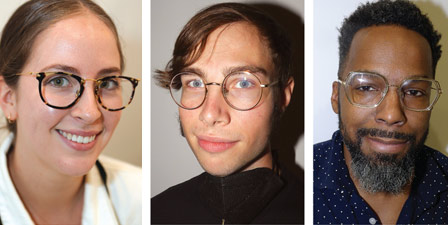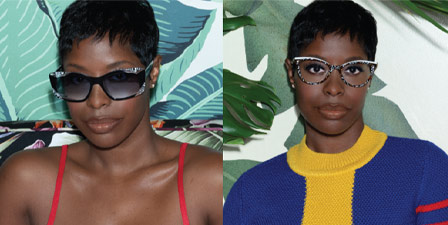
By Preston Fassel
BIG. BLACK. GLASSES.
The name of the individual is forever lost to us who sometime in the early 2000s, popped the lenses out of a pair of Ray-Ban Wayfarers, put them on and declared to the rest of the slumber party, “Look at me! I’m a geek!” Thus began the nascent geek chic craze—a brief, confusing time in our culture when it suddenly became acceptable for young people to wear clip-on suspenders with high-water jeans and Wayfarer knockoffs with plano (or no) lenses. Though the fad subsided nearly as abruptly as it came on, the effects were far-reaching. People used to seeing zyls only in films or on the faces of disaffected Gen-X art majors were now watching them pop up on a younger, more sartorially influential crowd…
BIG. BLACK. GLASSES.
The name of the individual is forever lost to us who sometime in the mid-2000s, put on a pair of plano-lensed Wayfarers, raised a can of domestically brewed, moderately priced beer and declared to his six roommates, “Look at me! It’s ironic!” Thus were born the hipsters, a nebulous subculture whose talent for ubiquity and affinity for ungainly eyewear further propelled zyls into the public spotlight.
BIG. BLACK. GLASSES.
Matthew Weiner was the name of the individual who created “Mad Men” in 2007. His show about morally conflicted Madison Avenue ad agents in the 1960s had far-reaching onsequences for the fashion industry, including the world of frame design. “Retro” was the word across the cultural spectrum, and that included zyl frames. Bucking a decades-old stigma, zyls were no longer simply the domain of the artistically or technologically inclined: Now, everyone was wearing them. There was just one problem: They were all…
BIG. BLACK. GLASSES.
As though suffering from total color-blindness, frame manufacturers churned out black frame after black frame, each one even less unique than the last. It was a troubling time in optics: While black was the only color available, not every wearer had the complexion to pull it off, and numerous early adoptees of zyl weren’t doing the emergent style any favors by donning frames that didn’t suit them. Would homogeny torpedo the nascent trend? Would people just plain get sick of black plastic glasses?

Into this dark and frightening quagmire came a ray of hope: A brown ray, with hints of yellow and a black accent. That ray was tortoiseshell.
Tortoiseshell has a long and complicated history in optics. Just as “horn-rimmed glasses” once referred to frames made from real horn, tortoiseshell glasses were once constructed from the shells of actual turtles, an expensive alternative for the wealthy and royalty to demonstrate they could afford something uniquely exotic. The colorful beauty of the pattern ensured that manufacturers quickly copied it for the masses, using a variety of plastics to offer it to consumers across the economic strata. Tortoiseshell glasses enjoyed a boom in popularity in the ’30s (particularly as sunglasses), but it wasn’t until the postwar years that the pattern really got its chance to shine in eyewear. Don’t be fooled by black and white photos: In the 1950s, the most popular color choice in frames was a dark tortoise pattern that simply looks black in pictures.
Now, in the 2010s, tortoise has reemerged from a long slumber to once again breathe life into eyewear. Cutting a swath through the onyx menace, the vibrancy of tortoise frames is even more brilliant than ever, representing a color palette whose diversity would make Pollack jealous. Of course, there’s the traditional Havana Tortoise, a mottling of dark browns with occasional black dappling; joining the fray are tortoise patterns in every color of the rainbow, representing nearly every variety of hue and design to be found on turtles in nature, and some that aren’t. Gray and black. Yellow and green. Even this year’s shade of the summer, navy blue, has entered the mix, blurring the lines between modern and traditional tortoise and allowing lucky consumers to look like the royals of yesteryear. This proliferation of color allows for a greater ability to match patients’ complexions to frames accordingly. Whereas black tends to wash out those with paler skin or dominate the faces of those with smaller features or finer bone structure, the numerous shades of tortoise allow for patients of any skin tone or face size to enjoy zyls while also enhancing their features instead of diminishing them. Another great selling point: Tortoiseshell glasses are 100 percent cruelty-free, as the use of real turtles was banned in the 1970s.
With this much-needed injection of artistic diversity, zyls can continue their dominance of the eyewear field unabated; the biggest enemy of any trend is a stifling omnipresence that leads devotees to seek out unique alternatives, and with the new varieties of tortoise being offered, it’s going to be quite a while before we reach oversaturation. In the meantime, we can sit back and enjoy the sights of this new, beautiful array of colors as they begin to appear on the faces of eyeglass wearers the world over. ■













